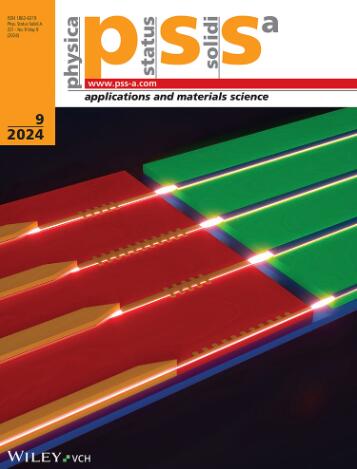Geometric Variability‐Aware Thermal Characteristics Modeling of Nanoscale Silicon Gate‐All‐around Nanowire Transistor
IF 1.9
4区 材料科学
Q3 MATERIALS SCIENCE, MULTIDISCIPLINARY
Physica Status Solidi A-applications and Materials Science
Pub Date : 2024-08-13
DOI:10.1002/pssa.202400435
引用次数: 0
Abstract
Thermal management becomes increasingly important in silicon gate‐all‐around (GAA) field‐effect transistor (FETs) for 3 nm technology node and beyond. The channel thermal conductivity significantly differs from bulk silicon. Precise determination of thermal conductivity is crucial for device evaluation and optimization. This study investigates the thermal conductivity of silicon nanowires, examining the complex interplay between size and channel orientation. The conventional nonequilibrium molecular dynamics (NEMD) method is used with the standard Stillinger–Weber potential at the atomic scale. The results indicate that the thermal conductivity of silicon nanowires along the [100] direction increases monotonically with both length (L) and cross‐sectional side length (D). Conversely, the [110] direction exhibits nonmonotonic variation in thermal conductivity with D, due to increased acoustic–optic phonon scattering. For GAA FET devices with a silicon nanowire channel of意识到几何变异性的纳米级硅栅极全方位纳米线晶体管热特性建模
在 3 纳米技术节点及以后的硅全栅(GAA)场效应晶体管(FET)中,热管理变得越来越重要。沟道热导率与块硅有很大不同。精确测定热导率对于器件评估和优化至关重要。本研究调查了硅纳米线的热导率,考察了尺寸和沟道取向之间复杂的相互作用。采用传统的非平衡分子动力学 (NEMD) 方法和原子尺度的标准 Stillinger-Weber 电位。结果表明,硅纳米线沿[100]方向的热导率随长度(L)和横截面边长(D)的增加而单调增加。相反,由于声光声子散射增加,[110] 方向的热导率随 D 呈现非单调变化。对于具有 L = 20 nm 和 D = 5 nm 硅纳米线通道的 GAA FET 器件,NEMD 计算得出 [100] 方向的热导率为 10.8 W m-K-1,[110] 方向的热导率为 25.3 W m-K-1。随后,通过计算机辅助设计技术分析了硅纳米线 GAA FET 中的自热效应 (SHE)。结果表明,具有 [110] 传输方向的硅纳米线更适合器件设计。
本文章由计算机程序翻译,如有差异,请以英文原文为准。
求助全文
约1分钟内获得全文
求助全文
来源期刊
CiteScore
3.70
自引率
5.00%
发文量
393
审稿时长
2 months
期刊介绍:
The physica status solidi (pss) journal group is devoted to the thorough peer review and the rapid publication of new and important results in all fields of solid state and materials physics, from basic science to applications and devices. Among the largest and most established international publications, the pss journals publish reviews, letters and original articles, as regular content as well as in special issues and topical sections.

 求助内容:
求助内容: 应助结果提醒方式:
应助结果提醒方式:


